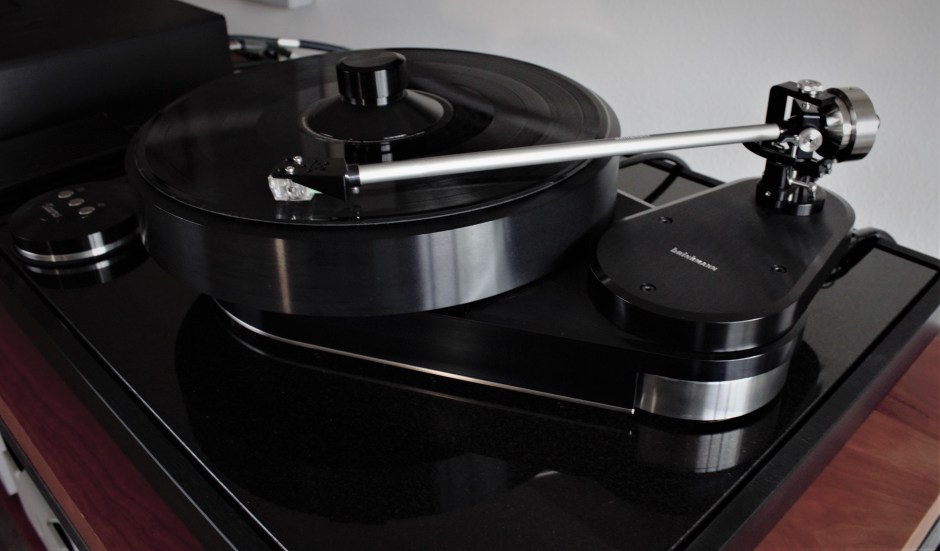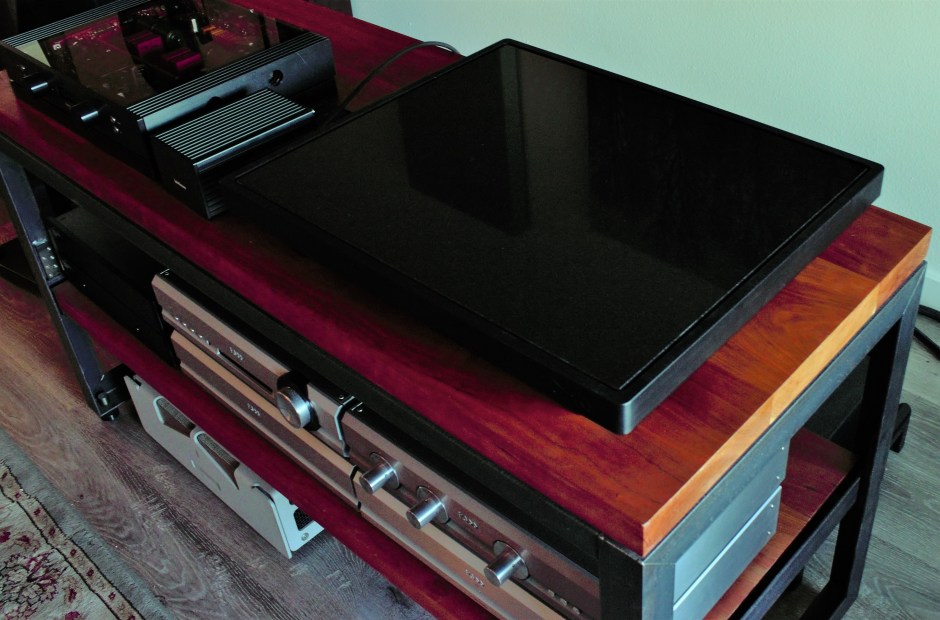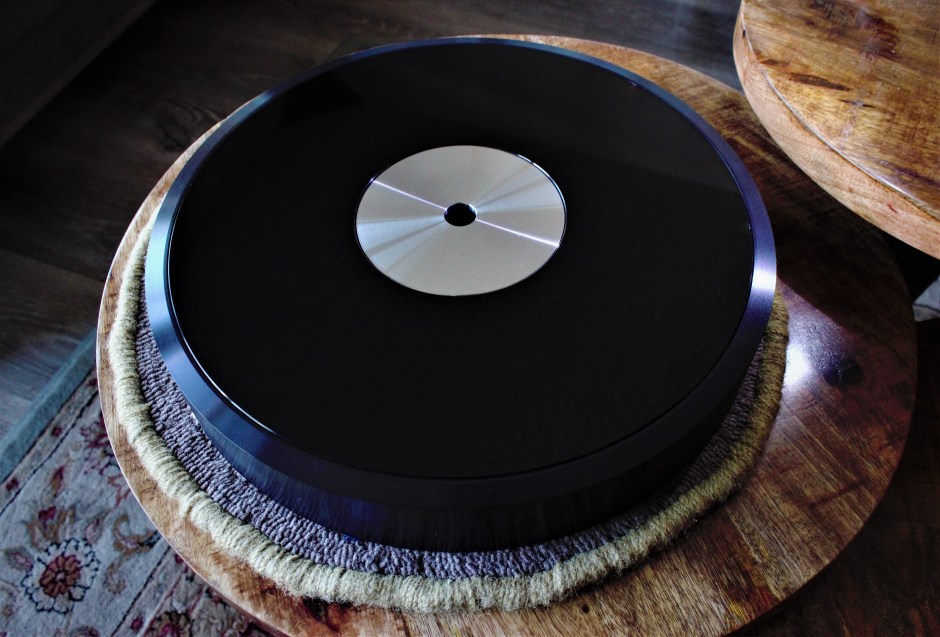It seems as if the better part of last year was focused on reviewing the Brinkmann Taurus turntable. First, I arranged for a series of cartridges and phono stages that would be suitable for this German-made direct-drive turntable. Then I had to time it in conjunction with the review for the Brinkmann Edison Mk. II phono stage, which I had on hand for quite some time.
It took some more time and focus in order to get the full Brinkmann rig up and running at once—we’re talking about the Brinkmann Taurus turntable, Brinkmann 12.1 tonearm and the Edison, plus a dedicated isolation platform from Harmonic Resolution Systems that had a shipping weight of 80 lbs. The supply chain issues over the last few months, of course, have been worse than usual–best laid plans, and all that. Plus, I learned a serious lesson about phono cables and high-end turntables, but I’ll get to that in a bit.
The Brinkmann Taurus is undoubtedly the most accomplished turntable I’ve reviewed. I’ve had hands-on experience with Continuum, Doehmann, SME and a few other giants, but not in depth like this.
By accomplished, I’m primarily referring to the engineering on this precision machine, and how every detail is bound by exceptionally tight tolerances and an incredible amount of thought and expertise straight from the mind and soul of Helmut Brinkmann. If you go to the Brinkmann website, you’ll see this sentence on the home page: “Listening to the sound of tiny screws is a vital part of Helmut Brinkmann’s routine.” After spending time with the Brinkmann Taurus, this is hardly surprising. Every square inch of this turntable is deliberate, more so than almost anything I’ve seen in high-end audio—an industry already obsessed with the tiniest of details.
My review period with the Brinkmann Taurus was probably extended a bit by yours truly because I was a little heartbroken about finally giving up that Technics SL-1200G turntable I’d borrowed from Scot Hull for three whole years. Ordinarily I’d switch to one of my back-up turntables, either the Unison Research Giro ‘table or a 2007 Rega P3-24 with quite a few mods. Oh yeah, I forgot that I just sold them last year—the sale happened so quick and unexpectedly that it still doesn’t register that I currently do not own a turntable for the first time since the early ‘70s. It’s a truly strange feeling, marked by unease and uncertainty.
How about the Brinkmann Taurus? Could it be the next and undoubtedly final turntable for me? Yes and no. Yes, because the sound quality I heard with the Taurus in my own system rivals anything I’ve heard—at my home, at a high-end audio show, at a high-end dealer or even in the listening room of a very well-heeled audiophile. No, because it’s far beyond my budget. It makes perfect sense, however, to move up from the Technics to the Brinkmann—they’re both direct drive and they both demonstrate how great these designs can sound. But there’s a clear step up in sound quality with the Brinkmann Taurus in the chain.
Did I constantly think about how I could keep the Brinkmann Taurus in my system for an indefinite amount of time, sitting on that massive HRS platform, impressing me daily with its poise and command of every LP placed upon its massive platter? You bet I schemed. Perhaps that’s the reason I held onto it like a winning lotto ticket. Both hands, real tight.
Inside the Brinkmann Taurus
If you want to more about my personal history with Brinkmann Audio in Germany, you can refer to my recent review of the Edison Mk. II. and discover where Brinkmann Audio and I have intersected at strange points in my life. I feel like they’re a part of my audio education, but I’ve had precious little seat time with their amazing product lines—turntables, arms (which share some DNA with the classic Breuer arms), amplifiers, phono stages, tuners, external power supplies and more.
Brinkmann has always made excellent, well-regarded turntables, traditionally with a belt drive. The Balance turntable, Brinkmann’s first product back in 1985, is still in production today. But in 2007 Brinkmann released the direct-drive Oasis, and since then the company has been a major force when it comes to re-introducing direct drive turntables to high-end audio. Rockport might’ve gotten there first, but Brinkmann did it at price points there weren’t so shocking to the uninitiated. After the Oasis came the Bardo, and now the Brinkmann Taurus, at $15,990, is the next step up the line. In fact, it is the flagship direct drive turntable for Brinkmann.
Helmut Brinkmann calls the Taurus “the finest direct drive turntable we could build.” It starts with the same bespoke magnetic field motor found in the Oasis and Bardo. As Brinkmann explains on its website:
“Built on a massive 40mm thick Duraluminum chassis inspired by Balance, Taurus delivers deeper, more visceral bass combined with the dynamic agility and forward drive which characterize all Brinkmann direct drive turntables. Taurus‘ chassis has been resonance-optimized to banish mechanical noise and enable the deep-black background for which Brinkmann turntables are renowned. In a further homage to our statement turntable, Taurus offers wireless speed selection via an engraved aluminum disc reminiscent of Balance’s hard-wired control.”
Anthony Chiarella gave me a bit more insight to this:
“Although the Taurus shares its platter and Sinus Motor (although this motor is differently tuned for Taurus than it is for Bardo) with Bardo, the Speed Controller is unique to Taurus, as are plinth, speed selector and other engineering details. It should also be noted that this motor has been designed by Helmut and is unique to Brinkmann. The motor on current Brinkmann Belt Drive ‘tables (Spyder and current-production Balance) is also a bespoke unit designed and manufactured by Brinkmann exclusively for use in our turntables.”
Simply put, the Brinkmann Taurus combines the best attributes of the Oasis and Bardo direct drive technology–and the structural benefits employed in the more expensive Balance. You can also upgrade the stock external power supply with the new RoNt III vacuum tube power supply and choose either the 9” or 12” version of the Brinkmann arm. And yes, you can get an additional armboard so you can buy both!
Cables, Platform and the Brinkmann 12.1 Tonearm
The Brinkmann Taurus turntable actually taught me a lesson about testing the finest analog rigs out there, something I didn’t know—at this level, you’re expected to come up with your own phono cable. I’ve seen this before, but I just didn’t think about it because someone upstream had already plugged one in. Fortunately, Anthony Chiarella (who also serves as the Director of Sales and Marketing for Brinkmann USA) sent out one of the Atlas Cables Mavros phono cables—I’ve already reviewed the Atlas Grun Earthing System with the Mavros line and found it quite effective in noise suppression and reducing distortion in my system.
I’m only mentioning this as an FYI—once you get to a turntable at this level, the need for a separate phono cable is something you might have to consider. It’s no different than having a turntable newbie expect that an arm, a cartridge and possibly even a phono stage will be included with every turntable purchase.
As far as the custom shelf from HRS goes, well, let’s just say that I haven’t spent a lot of money or even attention on isolation platforms in the past, and I may have been slightly skeptical of a heavy slab somehow extracting more performance from a machine of the Taurus’ caliber. More than once I though about that $3900 price, and how the entire Technics SL-1200G costs just $100 more.
Then, of course, I listened to the Brinkmann Taurus with and without the HRS platform. Let me temper my opinions by saying that the Taurus without the HRS sounded magnificent, and there was not quite a night-and-day difference once the HRS was installed. I didn’t feel that the tonality changed that much, but I did feel like the music leaped out at me with more speed and more energy than before with the platform under the ‘table. The HRS platform clarified the existing strengths of the Taurus and brought them out in vivid relief. Plus, the low frequencies were simply glorious with the HRS in place.
Verdict? If you’re going to spend the money on the Brinkmann Taurus and the 12.1 arm, you won’t hesitate to spend $4000 on the HRS. Consider it a Brinkmann Taurus SE, if you will. Now when assorted people in the industry tell me there’s nothing close to HRS, I can nod my head and act like I’ve know all about them for years.
Finally, we have the Brinkmann 12.1 tonearm, and I have to admit that’s the most exciting part about reviewing a Brinkmann turntable—for me, at least. Many years ago, I had a few brushes with tonearm greatness—the handmade Breuer Dynamic tonearm from Switzerland. Every time I’ve heard a turntable with a Breuer arm—first a Wilson-Benesch ACT One and then a J. A. Michell Orbe SE and finally a Brinkmann Balance—I thought the sound quality was simply extraordinary.
When Brinkmann started making their own tonearms, they looked just like the Breuer. I was told back then that Brinkmann bought the Breuer Dynamic design and was making them under the Brinkmann name. Since then, I’ve heard more complex variations, that Helmut took the basic design and of course listened to every screw and made the perfect even more so. If I had one goal for the review, it was to get the scoop on this once and for all.
As Anthony Chiarella explains:
“Prior to developing his own arms, Helmut had been the German Importer/Distributor for Breuer. He greatly admired the arm, referring to it as an “Arabian Stallion” in terms of its dynamic portrayal and used some if its ideas as the basis for his design. Eventually, Helmut developed and manufactured is own arm which, though sharing certain similarities, is actually quite different from the Breuer. Herr Breuer had seen Helmut’s arm prior to its introduction and also considered it different enough so as not to be an infringement of the Breuer design. Interestingly, all Brinkmann tonearms are wired with Breuer Litz Wire, which Helmut considers the best arm wire he has heard.”
The cost of the Taurus with the Brinkmann 12.1 tonearm comes to $21,490–you save $1000 when you buy them as a package.
Brinkmann Taurus Set-up
The Brinkmann Taurus turntable was relatively easy to set up for a high-mass turntable this sophisticated. This was largely since the Taurus comes in just a few big pieces, and it’s fairly obvious what goes where and how. Plus, you don’t even have to futz with placing a belt in a pulley! I have to admit that at one point I was looking for the belt. Forehead slappin’ time indeed.
When I had a question or concern during assembly of the Taurus, a Helmut-like apparition always appeared in front of me to explain the logic, reason and pure engineering prowess of that design choice. For instance, I was concerned about how the heavy round base under the arm board could be fastened to the main plinth—I was convinced that the base had to touch the ground underneath to support the turntable on that side. No, it hangs in the round slot, suspended, just a couple of millimeters from the surface underneath. That seemed strange until I realize that the entire turntable would be more balanced at the furthest points once the very heavy platter was installed. Engineering, with a capital E.
The main turntable assembly, sans 22 lb. platter, isn’t even that bulky or heavy. It’s far lighter than the HRS stand, even with the platter. You simply center the spindle over the exact center of the HRS and start building from there. You have to take care with installing the platter—it is very heavy and Brinkmann suggests that two people gently lower it onto the main bearing. There’s one more piece of the puzzle, and that’s the outboard motor. It comes in the same enclosure as the power supply for the Edison Mk. II power supply, so they look kind of cool sitting next to each other on my equipment rack.
One more cool little piece of the Brinkmann Taurus puzzle—the actual speed control pod. It’s small, round, and it sits on top of a sheet of felt that’s then placed on the HRS base. It’s wireless, so it looks awesome sitting there, connected to nothing, but running everything so smoothly.
Many cartridges wound up mounted on the Brinkmann turntable, basically everything I’ve review since last summer. My two favorites were the Koetsu Urushi Black, with or without the Koetsu Stepup Transformer, and the ZYX Ultimate Airy X. That’s right, the same ZYX Ultimate Airy X I received almost a year ago in anticipation of the arrival of the Taurus. Besides the Brinkmann Edison Mk. II, the Taurus was plugged into the Pass Labs XP-27, the Allnic Audio H-5500 and The Grail from Van den Hul.
Brinkmann Taurus Sound
Before we get into the sound of the Brinkmann Taurus turntable, let’s summarize the Technics SL-1200G and why I finally changed my mind about direct drive sound. People first noticed I existed when I told them the original SL-1200s sounded horrible because they were direct drive turntables. Seems so long ago now.
I never liked the sound of the original Technics SL-1200 because it was dark and small, especially when compared to belt-drive designs at its price point. With the radically redesigned and far more expensive Technics SL-1200G, about 99% of the offending darkness and smallness was eliminated, allowing me to finally enjoy that fabulous speed stability and rock-bottom bass. That remaining 1%? Well, I can still hear that darkness and smallness, ever so faintly, almost a reminder that, in spirit, this was still a ‘1200 deep down. Someone even suggested that I was just hearing the Technics “sound,” which was an intentional signature.
Now take that 1200G sound, remove all that 1% of doubt. Now expand the soundstage in every single direction. Now add that very solid and powerful presentation that a high-mass analog rig brings to the equation, that sense of being set into the groove and not going anywhere until the music is done. In that sense, the Brinkmann Taurus reminds me less of the Technics and more like some of my favorite high-mass belt-drive ‘tables such as the Dr. Feickert Analogue Firebird and the Palmer 2.5i.
I’m not pushing the comparisons between the Technics and the Brinkmann. The differences are not subtle, nor is the difference in price. But the Brinkmann Taurus sound is an extension of what I like about the Technics, with every last bit of doubt erased. But if you love the sound of the 1200G or 1210G but you want an upgrade, you could get in line for a Technics SR-1000. Or, you could go with the Bardo or the Taurus. It will make perfect sense to you if you’re in this enviable situation.
I certainly couldn’t come up with any criticisms of the sound as time passed, a little more something that I wish the Taurus had but didn’t. At the same time, the Brinkmann Taurus isn’t one of those superb components that offers no discernible signature and sounds completely and utterly neutral. That’s because the bass response of this puppy, along with the Edison Mk. II and the Koetsu Urushi Black, was unlike anything I’ve heard before.
This isn’t about Hz. This is about opening up a trap door in between the speakers, of revealing a whole new soundstage underneath your feet. I wasn’t hearing more bass than ever before—I was listening to more details about those lowest frequencies. This was something I heard consistently despite the speakers I used—I had the Nola Champ3s, which go nice and deep, and I also had a bevy of overachieving two-way monitors such as the Harbeth Compact 7ES-3 XDs and the Brigadiers BA-2 monitors from Australia. Even the Fern and Roby Raven III, with its high-efficiency and full range single driver, could sound immense without breaking a sweat.
Listening to the Brinkmann Taurus
As I mentioned in the review of the Edison Mk. II, this Brinkmann rig commanded me to play all of my most glorious and rare LPs, on the double, leading me to some of the most reward listening sessions in many years. Those heavenly three-dimensional low frequencies could pull out so much energy and detail from double basses, kick drums, cajons and pipe organs, allowing you to connect effortlessly with the human on the opposite side of the sound—one of my sonic priorities.
There was one bonus to using the Koetsu Urushi Black cartridge with the Brinkmann Taurus and 12.1 arm. I’ve always maintained that Koetsus are magical when it comes to relegating pops and clicks to the far boundaries of the soundstage, and this became far more obvious with the Taurus. When I think of audiophiles who shy away from LPs because they have bad memories of their neglected vinyl, I want to sit them down in front of something like this. The combination doesn’t eliminate surface noise, which would be a dumb claim, but you just don’t care anymore. It’s no more intrusive than the sound of your own breathing.
The best test for this is my beloved yet wildly overplayed Athena pressing of Rachmaninoff’s Symphonic Dances and Vocalise performed by Donald Johanos and the Dallas Symphony. There was a point, many years ago, where I almost had to retire this permanently from my playlist. I’ve actually brought this album back from the dead with a steady diet of enzyme cleaners and even ultrasonic treatments—it’s been my guinea pig for testing new record cleaning products ever since.
There’s still a healthy dose of surface noise, but it’s much more tolerable than before. On the Brinkmann Taurus and the Koetsu Urushi Black, however, I got through the entire second side, removed the LP, and suddenly realized that there wasn’t one point where I thought about the surface noise at all, whether it was sounding better or worse than before. I simply didn’t notice. It was still there, of course, but it didn’t detract from my love of this album.
I’ve heard this phenomenon before with Koetsu cartridges, and others have mentioned it as well. With the Brinkmann Taurus turntable, 12.1 tonearm, and the Brinkmann Edison Mk. II, it became a whole new, energized argument for why analog still beats the pants off digital.
Conclusion
Full disclosure—I went ahead and pulled the trigger on a new Technics SL-1210G, the non-collector’s edition of the SL-1210GAE Anniversary ‘table I reviewed last year. I need a work horse, something that can play back-up quarterback with less than stellar LPs or mid-priced cartridges. The Brinkmann Taurus turntable with the 12.1 tonearm would be reserved for something special, not parked in the garage like Ferrari owned by Cameron Frye’s dad, but as a thoroughbred for esoteric cartridges and rare LPs. Feed it only the best, I’d say. I could see a well-defined future with both, hooked into the multiple inputs of the Edison Mk. II.
The Brinkmann Taurus gave me such a sense of a final word, however, that the music I was hearing couldn’t sound any better than right here. I’m not saying that the Brinkmann Taurus turntable is the best or anything like that. But as I walk along this audio journey of mine, as we all are doing, I’m struck with the sense that it’s going to be hard to imagine a turntable that achieves finer performance than this. Perhaps I’ll hear something in the future that surpasses the Taurus—it’s not even the top of the Brinkmann turntable line!—and I refuse to keep saying that this is the best, no, this is the best, no, IT’S THIS ONE! I feel like I’ve rounded a corner on my journey, however, and I’ve seen (heard) something I haven’t seen (heard) before. And maybe it’s a big highlight of my trip so far.
The Brinkmann Taurus provides you with the speed stability, precise imaging and impressive low frequency performance typical of good direct-drive sound. It provides you with the energy and liveliness and vast soundstaging abilities of the finest belt-drives. It is a serious precision machine design to play records—it looks and feels like something far more technical than a mere record player—and it does so with uncommon grace and poise. Highly recommended.






















Great review, thanks. Two questions:
Do you find annoying using the clamp? I love my RP10 as I If you were to chose: Taurus or Linn new fully loaded Klimax? I know, I know, different technology. But ultimately, it is about the music coming out of the speakers. Which one would you chose (old rock, vocals, some jazz on tube preamp and power amp)?
Thanks, Luis
I’ve been using clamps and weights for years, so I’m used to dealing with one. I haven’t heard a Linn in many years, but I’d love to revisit it one day. Linn distribution in the US has been spotty over the last few years, so I don’t know when I’ll get the chance.
Mark, great review.
What are the monitor speakers that are in the picture of your system?
Thanks
Dan
Hi Dan, those are my Trenner & Friedl ART monitors. I’ve had them for 11 years now.